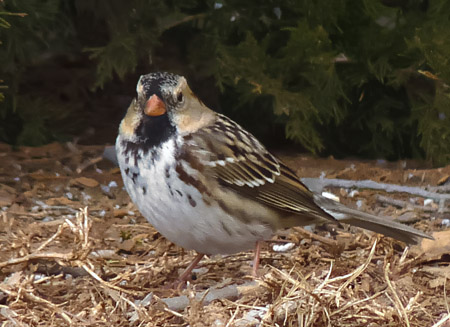
It was the middle of January 1958 and our family was moving from North Carolina to Oklahoma City. I was 16 and my siblings and I could not wait to see our first oil well, and I could not wait to see my first “new” bird. We stopped for a break in eastern Oklahoma and I went bird watching a few minutes in some promising scrubby oak habitat. And there was my first new Oklahoma species: a group of Harris’s Sparrow (Zonotrichia querula). At first I did not know what species they were; I remember being confused by the varying amounts of black on the head and throat of the birds I was seeing. According to G. M. Sutton (1977, Fifty Common Birds of Oklahoma), the Harris’s Sparrow “winters throughout Oklahoma…[and is] commonest in the central and northeastern parts of the state.” It was a great bird to start my list of new Oklahoma birds.
The Harris’s Sparrow has remarkable connections to Oklahoma. This species was one of the last of North American birds to have its eggs discovered, and the honor went to Dr. George M. Sutton who found a nest containing them in the Churchill, Manitoba, area of Canada, during the summer of 1931. Upon finding the nest, Dr. Sutton described his feelings (A.C. Bent, 1968, Life histories of North American Cardinals, Grosbeaks, Buntings, Towhees, Finches, Sparrows, and Allies): “As I knelt to examine the nest a thrill the like of which I had never known before passed through me. And I talked aloud! ‘Here’ I said. ‘Here in this beautiful place!’ At my fingertips lay treasures that were beyond price. Mine was Man’s first glimpse of the eggs of the Harris’s Sparrow, in the lovely birds wilderness home.”
The Harris’s Sparrow lays 3 to 5 eggs that have a ground color of white or greenish-white and are heavily speckled with brown. Later, Dr. Sutton became closely identified with Oklahoma ornithology when he moved to the state in 1952.
Another Harris’s Sparrow connection to the state involved Marguerite Baumgartner; she and her husband Fred were longtime ornithologists at Oklahoma State University in Stillwater, Oklahoma. Between 1948-1965 Marguerite banded the remarkable total of 1,722 Harris’s Sparrows on their property in the Stillwater area. Even after such an extensive study, Marguerite was able to draw few hard and fast rules relating plumage to age in Harris’s Sparrow. “None of the returns [i.e., birds returning as 2nd year adults or older] had the broad, buffy ‘eyebrows’ almost meeting on the forehead that characterize the first winter plumage…[and] birds whose throats were more than half white…[and] usually showed the buffy eyebrows…were designated immatures.” In those birds that she considered adult Harris’s Sparrow, she found at least 4 different plumages, and there was considerable variation within each of these 4 plumage types. Not many North American bird species show such variable—and potentially confusing—plumages. Because of her extensive experience with banding the Harris’s Sparrow, Marguerite Baumgartner was honored by A. C. Bent to be the one to write up the life history of the Harris’s Sparrow for his life history series (Bent, 1968).
